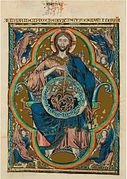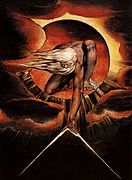Mathematics and art
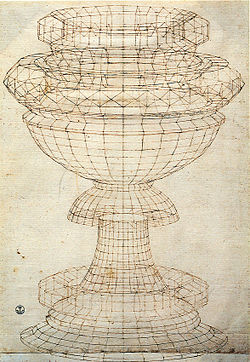
| Part of a series on | ||
| Mathematics | ||
|---|---|---|
|
|
||
|
| ||
Mathematics and art are related in a variety of ways. Mathematics has itself been described as an art motivated by beauty. Mathematics can be discerned in arts such as music, dance, painting, architecture, sculpture, and textiles. This article focuses, however, on mathematics in the visual arts.
Mathematics and art have a long historical relationship.
vaulting.Mathematics has directly influenced art with conceptual tools such as
Other relationships include the algorithmic analysis of artworks by
Origins: from ancient Greece to the Renaissance
Polykleitos's Canon and symmetria
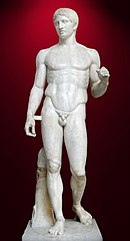
The Canon itself has been lost but it is conjectured that Polykleitos used a sequence of proportions where each length is that of the diagonal of a square drawn on its predecessor, 1:√2 (about 1:1.4142).[4]
The influence of the Canon of Polykleitos is immense in
Perspective and proportion
In classical times, rather than making distant figures smaller with
The rudiments of perspective arrived with
The Italian painter Paolo Uccello (1397–1475) was fascinated by perspective, as shown in his paintings of The Battle of San Romano (c. 1435–1460): broken lances lie conveniently along perspective lines.[12][13]
The painter
In De Prospectiva Pingendi, Piero transforms his empirical observations of the way aspects of a figure change with point of view into mathematical proofs. His treatise starts in the vein of Euclid: he defines the point as "the tiniest thing that is possible for the eye to comprehend".
The artist
In 1509,
As early as the 15th century, curvilinear perspective found its way into paintings by artists interested in image distortions. Jan van Eyck's 1434 Arnolfini Portrait contains a convex mirror with reflections of the people in the scene,[35] while Parmigianino's Self-portrait in a Convex Mirror, c. 1523–1524, shows the artist's largely undistorted face at the centre, with a strongly curved background and artist's hand around the edge.[36]
Three-dimensional space can be represented convincingly in art, as in technical drawing, by means other than perspective. Oblique projections, including cavalier perspective (used by French military artists to depict fortifications in the 18th century), were used continuously and ubiquitously by Chinese artists from the first or second centuries until the 18th century. The Chinese acquired the technique from India, which acquired it from Ancient Rome. Oblique projection is seen in Japanese art, such as in the Ukiyo-e paintings of Torii Kiyonaga (1752–1815).[37]
-
Woodcut fromDe divina proportione with an equilateral triangleon a human face
-
Camera lucida in use. Scientific American, 1879
-
Illustration of an artist using a camera obscura. 17th century
-
Proportion: Leonardo's Vitruvian Man, c. 1490
-
Basilica of Santa Maria Novella
-
Diagram fromDella Pittura, with pillars in perspective on a grid
-
Linear perspective in Piero della Francesca's Flagellation of Christ, c. 1455–1460
-
convex mirror in Jan van Eyck's Arnolfini Portrait, 1434
-
Parmigianino, Self-portrait in a Convex Mirror, c. 1523–1524
-
Pythagoras with tablet of ratios, in Raphael's The School of Athens, 1509
-
Oblique projection: Entrance and yard of a yamen. Detail of scroll about Suzhou by Xu Yang, ordered by the Qianlong Emperor. 18th century
-
Oblique projection: women playing Shogi, Go and Ban-sugoroku board games. Painting by Torii Kiyonaga, Japan, c. 1780
Golden ratio
The
Another ratio, the only other morphic number,[56] was named the plastic number[c] in 1928 by the Dutch architect Hans van der Laan (originally named le nombre radiant in French).[57] Its value is the solution of the cubic equation
- ,
an irrational number which is approximately 1.325. According to the architect Richard Padovan, this has characteristic ratios 3/4 and 1/7, which govern the limits of human perception in relating one physical size to another. Van der Laan used these ratios when designing the 1967 St. Benedictusberg Abbey church in the Netherlands.[57]
-
Base:hypotenuse(b:a) ratios for the3-4-5 Triangle), or 1:4/π
-
Supposed ratios:Notre-Dame of Laon
-
Golden rectangles superimposed on the Mona Lisa
Planar symmetries

Many traditional rugs, whether pile carpets or flatweave kilims, are divided into a central field and a framing border; both can have symmetries, though in handwoven carpets these are often slightly broken by small details, variations of pattern and shifts in colour introduced by the weaver.[59] In kilims from Anatolia, the motifs used are themselves usually symmetrical. The general layout, too, is usually present, with arrangements such as stripes, stripes alternating with rows of motifs, and packed arrays of roughly hexagonal motifs. The field is commonly laid out as a wallpaper with a wallpaper group such as pmm, while the border may be laid out as a frieze of frieze group pm11, pmm2 or pma2. Turkish and Central Asian kilims often have three or more borders in different frieze groups. Weavers certainly had the intention of symmetry, without explicit knowledge of its mathematics.[59] The mathematician and architectural theorist Nikos Salingaros suggests that the "powerful presence"[58] (aesthetic effect) of a "great carpet"[58] such as the best Konya two-medallion carpets of the 17th century is created by mathematical techniques related to the theories of the architect Christopher Alexander. These techniques include making opposites couple; opposing colour values; differentiating areas geometrically, whether by using complementary shapes or balancing the directionality of sharp angles; providing small-scale complexity (from the knot level upwards) and both small- and large-scale symmetry; repeating elements at a hierarchy of different scales (with a ratio of about 2.7 from each level to the next). Salingaros argues that "all successful carpets satisfy at least nine of the above ten rules", and suggests that it might be possible to create a metric from these rules.[58]
Elaborate lattices are found in Indian Jali work, carved in marble to adorn tombs and palaces.[60] Chinese lattices, always with some symmetry, exist in 14 of the 17 wallpaper groups; they often have mirror, double mirror, or rotational symmetry. Some have a central medallion, and some have a border in a frieze group.[63] Many Chinese lattices have been analysed mathematically by Daniel S. Dye; he identifies Sichuan as the centre of the craft.[64]

Symmetries are prominent in textile arts including quilting,[61] knitting,[65] cross-stitch, crochet,[66] embroidery[67][68] and weaving,[69] where they may be purely decorative or may be marks of status.[70] Rotational symmetry is found in circular structures such as domes; these are sometimes elaborately decorated with symmetric patterns inside and out, as at the 1619 Sheikh Lotfollah Mosque in Isfahan.[71] Items of embroidery and lace work such as tablecloths and table mats, made using bobbins or by tatting, can have a wide variety of reflectional and rotational symmetries which are being explored mathematically.[72]
-
Hotamis kilim (detail), central Anatolia, early 19th century
-
Detail of aMing Dynasty brocade, using a chamfered hexagonal latticepattern
-
Symmetries: Florentine Bargello pattern tapestry work
-
Ceiling of the Sheikh Lotfollah Mosque, Isfahan, 1619
-
Darb-i Imamshrine, Isfahan, 1453
-
Fes, Morocco
-
The complex geometry and tilings of the muqarnas vaulting in the Sheikh Lotfollah Mosque, Isfahan
-
Architect's plan of a muqarnas quarter vault. Topkapı Scroll
Polyhedra
The
Dürer's well-known engraving Melencolia I depicts a frustrated thinker sitting by a truncated triangular trapezohedron and a magic square.[1] These two objects, and the engraving as a whole, have been the subject of more modern interpretation than the contents of almost any other print,[1][79][80] including a two-volume book by Peter-Klaus Schuster,[81] and an influential discussion in Erwin Panofsky's monograph of Dürer.[1][82]
-
The first printed illustration of aDe Divina Proportione, 1509
Fractal dimensions

Traditional Indonesian wax-resist batik designs on cloth combine representational motifs (such as floral and vegetal elements) with abstract and somewhat chaotic elements, including imprecision in applying the wax resist, and random variation introduced by cracking of the wax. Batik designs have a fractal dimension between 1 and 2, varying in different regional styles. For example, the batik of Cirebon has a fractal dimension of 1.1; the batiks of Yogyakarta and Surakarta (Solo) in Central Java have a fractal dimension of 1.2 to 1.5; and the batiks of Lasem on the north coast of Java and of Tasikmalaya in West Java have a fractal dimension between 1.5 and 1.7.[86]
The drip painting works of the modern artist Jackson Pollock are similarly distinctive in their fractal dimension. His 1948 Number 14 has a coastline-like dimension of 1.45, while his later paintings had successively higher fractal dimensions and accordingly more elaborate patterns. One of his last works, Blue Poles, took six months to create, and has the fractal dimension of 1.72.[87]
A complex relationship
The astronomer

Mathematics as an art
The mathematician Jerry P. King describes mathematics as an art, stating that "the keys to mathematics are beauty and elegance and not dullness and technicality", and that beauty is the motivating force for mathematical research.[91] King cites the mathematician G. H. Hardy's 1940 essay A Mathematician's Apology. In it, Hardy discusses why he finds two theorems of classical times as first rate, namely Euclid's proof there are infinitely many prime numbers, and the proof that the square root of 2 is irrational. King evaluates this last against Hardy's criteria for mathematical elegance: "seriousness, depth, generality, unexpectedness, inevitability, and economy" (King's italics), and describes the proof as "aesthetically pleasing".[92] The Hungarian mathematician Paul Erdős agreed that mathematics possessed beauty but considered the reasons beyond explanation: "Why are numbers beautiful? It's like asking why is Beethoven's Ninth Symphony beautiful. If you don't see why, someone can't tell you. I know numbers are beautiful."[93]
Mathematical tools for art
Mathematics can be discerned in many of the arts, such as

The artist Richard Wright argues that mathematical objects that can be constructed can be seen either "as processes to simulate phenomena" or as works of "
Some of the first works of computer art were created by
-
Mathematical sculpture by Bathsheba Grossman, 2007
-
Fractal sculpture: 3D Fraktal 03/H/dd by Hartmut Skerbisch, 2003
-
Fibonacci word: detail of artwork by Samuel Monnier, 2009
-
Computer art image produced by Desmond Paul Henry's "Drawing Machine 1", exhibited 1962
-
A Bird in Flight, by Hamid Naderi Yeganeh, 2016, constructed with a family of mathematical curves.
From mathematics to art

The mathematician and
Maurice Princet joined us often ... it was as an artist that he conceptualized mathematics, as an aesthetician that he invoked n-dimensional continuums. He loved to get the artists interested in the new views on space that had been opened up by Schlegel and some others. He succeeded at that.[121]
The impulse to make teaching or research models of mathematical forms naturally creates objects that have symmetries and surprising or pleasing shapes. Some of these have inspired artists such as the
Man Ray photographed some of the mathematical models in the

The artists Theo van Doesburg and Piet Mondrian founded the De Stijl movement, which they wanted to "establish a visual vocabulary comprised of elementary geometrical forms comprehensible by all and adaptable to any discipline".[131][132] Many of their artworks visibly consist of ruled squares and triangles, sometimes also with circles. De Stijl artists worked in painting, furniture, interior design and architecture.[131] After the breakup of De Stijl, Van Doesburg founded the Avant-garde Art Concret movement, describing his 1929–1930 Arithmetic Composition, a series of four black squares on the diagonal of a squared background, as "a structure that can be controlled, a definite surface without chance elements or individual caprice", yet "not lacking in spirit, not lacking the universal and not ... empty as there is everything which fits the internal rhythm". The art critic Gladys Fabre observes that two progressions are at work in the painting, namely the growing black squares and the alternating backgrounds.[133]
The mathematics of tessellation, polyhedra, shaping of space, and self-reference provided the graphic artist M. C. Escher (1898—1972) with a lifetime's worth of materials for his woodcuts.[134][135] In the Alhambra Sketch, Escher showed that art can be created with polygons or regular shapes such as triangles, squares, and hexagons. Escher used irregular polygons when tiling the plane and often used reflections, glide reflections, and translations to obtain further patterns. Many of his works contain impossible constructions, made using geometrical objects which set up a contradiction between perspective projection and three dimensions, but are pleasant to the human sight. Escher's Ascending and Descending is based on the "impossible staircase" created by the medical scientist Lionel Penrose and his son the mathematician Roger Penrose.[136][137][138]
Some of Escher's many tessellation drawings were inspired by conversations with the mathematician
The visual intricacy of mathematical structures such as tessellations and polyhedra have inspired a variety of mathematical artworks.
The distorted perspectives of anamorphosis have been explored in art since the sixteenth century, when Hans Holbein the Younger incorporated a severely distorted skull in his 1533 painting The Ambassadors. Many artists since then, including Escher, have make use of anamorphic tricks.[143]
The mathematics of
A liberal arts inquiry project examines connections between mathematics and art through the Möbius strip, flexagons, origami and panorama photography.[151]
Mathematical objects including the
-
Four-dimensional space to Cubism: Esprit Jouffret's 1903 Traité élémentaire de géométrie à quatre dimensions.[163][e]
-
De Stijl: Theo van Doesburg's geometric Composition I (Still Life), 1916
-
A Möbius strip scarf in crochet, 2007
-
Anamorphism: The Ambassadors by Hans Holbein the Younger, 1533, with severely distorted skull in foreground
-
hyperbolic planes with varying parameters by Margaret and Christine Wertheim. Föhr Reef, Tübingen, 2013
Illustrating mathematics
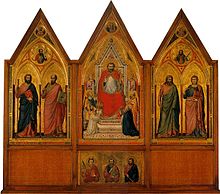

Modelling is far from the only possible way to illustrate mathematical concepts. Giotto's Stefaneschi Triptych, 1320, illustrates recursion in the form of mise en abyme; the central panel of the triptych contains, lower left, the kneeling figure of Cardinal Stefaneschi, holding up the triptych as an offering.[165] Giorgio de Chirico's metaphysical paintings such as his 1917 Great Metaphysical Interior explore the question of levels of representation in art by depicting paintings within his paintings.[166]
Art can exemplify logical paradoxes, as in some paintings by the

Salvador Dalí's last painting, The Swallow's Tail (1983), was part of a series inspired by René Thom's catastrophe theory.[171] The Spanish painter and sculptor Pablo Palazuelo (1916–2007) focused on the investigation of form. He developed a style that he described as the geometry of life and the geometry of all nature. Consisting of simple geometric shapes with detailed patterning and coloring, in works such as Angular I and Automnes, Palazuelo expressed himself in geometric transformations.[7]
The artist Adrian Gray practises

Artists, however, do not necessarily take geometry literally. As Douglas Hofstadter writes in his 1980 reflection on human thought, Gödel, Escher, Bach, by way of (among other things) the mathematics of art: "The difference between an Escher drawing and non-Euclidean geometry is that in the latter, comprehensible interpretations can be found for the undefined terms, resulting in a comprehensible total system, whereas for the former, the end result is not reconcilable with one's conception of the world, no matter how long one stares at the pictures." Hofstadter discusses the seemingly paradoxical lithograph Print Gallery by M. C. Escher; it depicts a seaside town containing an art gallery which seems to contain a painting of the seaside town, there being a "strange loop, or tangled hierarchy" to the levels of reality in the image. The artist himself, Hofstadter observes, is not seen; his reality and his relation to the lithograph are not paradoxical.[170] The image's central void has also attracted the interest of mathematicians Bart de Smit and Hendrik Lenstra, who propose that it could contain a Droste effect copy of itself, rotated and shrunk; this would be a further illustration of recursion beyond that noted by Hofstadter.[173][174]
Analysis of art history
Algorithmic analysis of images of artworks, for example using
The computer scientist Neil Dodgson investigated whether Bridget Riley's stripe paintings could be characterised mathematically, concluding that while separation distance could "provide some characterisation" and global entropy worked on some paintings, autocorrelation failed as Riley's patterns were irregular. Local entropy worked best, and correlated well with the description given by the art critic Robert Kudielka.[181]
The American mathematician
Stimuli to mathematical research
Art has sometimes stimulated the development of mathematics, as when Brunelleschi's theory of perspective in architecture and painting started a cycle of research that led to the work of Brook Taylor and Johann Heinrich Lambert on the mathematical foundations of perspective drawing,[183] and ultimately to the mathematics of projective geometry of Girard Desargues and Jean-Victor Poncelet.[184]
The Japanese paper-folding art of
-
Stimulus to projective geometry: Alberti's diagram showing a circle seen in perspective as an ellipse. Della Pittura, 1435–1436
Illusion to Op art

Sacred geometry
A strand of art from Ancient Greece onwards sees God as the geometer of the world, and the world's geometry therefore as sacred. The belief that God created the universe according to a geometric plan has ancient origins.
-
God the geometer.Codex Vindobonensis, c. 1220
-
The creation, with thePantocrator bearing. Bible of St Louis, c. 1220–1240
-
Johannes Kepler's Platonic solid model of planetary spacing in the Solar System from Mysterium Cosmographicum, 1596
-
William Blake's The Ancient of Days, 1794
-
William Blake's Newton, c. 1800
See also
Notes
- ^ In Piero's Italian: "una cosa tanto picholina quanto e possible ad ochio comprendere".
- ^ The ratio of the slant height to half the base length is 1.619, less than 1% from the golden ratio, suggesting the use of the Kepler triangle (face angle 51°49').[43][44] However, other ratios are within measurement error of the same shape, and historical evidence suggests that simple integer ratios are more likely to have been used.[45][46]
- ^ 'Plastic' named the ability to take on a chosen three-dimensional shape.
- ^ Images and videos of Hinke Osinga's crocheted Lorenz manifold reached international television news, as can be seen in the linked website.[152]
- ^ Maurice Princet gave a copy to Pablo Picasso, whose sketchbooks for Les Demoiselles d'Avignon illustrate Jouffret's influence.[114][164]
References
- ^ a b c d Ziegler, Günter M. (3 December 2014). "Dürer's polyhedron: 5 theories that explain Melencolia's crazy cube". The Guardian. Retrieved 27 October 2015.
- ^ S2CID 13387519.
- ^ S2CID 162410725.
- ^ S2CID 191362470.
- S2CID 170092094.
- ^ a b c O'Connor, J. J.; Robertson, E. F. (January 2003). "Mathematics and art – perspective". University of St Andrews. Retrieved 1 September 2015.
- ^ ISBN 978-0-262-05048-7.
- Lives of the Artists. Torrentino. p. Chapter on Brunelleschi.
- ^ Alberti, Leon Battista; Spencer, John R. (1956) [1435]. On Painting. Yale University Press.
- ISBN 978-0-19-852394-9.
- ^ Witcombe, Christopher L. C. E. "Art History Resources". Retrieved 5 September 2015.
- ^ a b c d e Hart, George W. "Polyhedra in Art". Retrieved 24 June 2015.
- ISBN 978-1-285-44932-6.
which illustrate Uccello's fascination with perspective. The jousting combatants engage on a battlefield littered with broken lances that have fallen in a near-grid pattern and are aimed toward a vanishing point somewhere in the distance.
- ^ della Francesca, Piero (1942) [c. 1474]. G. Nicco Fasola (ed.). De prospectiva pingendi. Florence.
{{cite book}}: CS1 maint: location missing publisher (link) - ^ della Francesca, Piero (1970) [Fifteenth century]. G. Arrighi (ed.). Trattato d'Abaco. Pisa.
{{cite book}}: CS1 maint: location missing publisher (link) - ^ della Francesca, Piero (1916). G. Mancini (ed.). L'opera "De corporibus regularibus" di Pietro Franceschi detto della Francesca usurpata da Fra Luca Pacioli.
- ^ Vasari, Giorgio (1878). G. Milanesi (ed.). Le Opere, volume 2. p. 490.
- ^ Zuffi, Stefano (1991). Piero della Francesca. L'Unità – Mondadori Arte. p. 53.
- ^ Heath, T. L. (1908). The Thirteen Books of Euclid's Elements. Cambridge University Press. p. 97.
- ^ Grendler, P. (1995). "What Piero Learned in School: Fifteenth-Century Vernacular Education". In M.A. Lavin (ed.). Piero della Francesca and His Legacy. University Press of New England. pp. 161–176.
- ^ Alberti, Leon Battista; Grayson, Cecil (trans.) (1991). Kemp, Martin (ed.). On Painting. Penguin Classics.
- ^ Peterson, Mark. "The Geometry of Piero della Francesca".
In Book I, after some elementary constructions to introduce the idea of the apparent size of an object being actually its angle subtended at the eye, and referring to Euclid's Elements Books I and VI, and Euclid's Optics, he turns, in Proposition 13, to the representation of a square lying flat on the ground in front of the viewer. What should the artist actually draw? After this, objects are constructed in the square (tilings, for example, to represent a tiled floor), and corresponding objects are constructed in perspective; in Book II prisms are erected over these planar objects, to represent houses, columns, etc.; but the basis of the method is the original square, from which everything else follows.
- ISBN 978-0-500-28638-8.
- ^ Van Riper, Frank. "Hockney's 'Lucid' Bomb At the Art Establishment". The Washington Post. Retrieved 4 September 2015.
- ^ Marr, Andrew (7 October 2001). "What the eye didn't see". The Guardian. Retrieved 4 September 2015.
- ^ Janson, Jonathan (25 April 2003). "An Interview with Philip Steadman". Essential Vermeer. Retrieved 5 September 2015.
- ISBN 978-0-19-280302-3.
- ^ Hart, George. "Luca Pacioli's Polyhedra". Retrieved 13 August 2009.
- ^ Morris, Roderick Conway (27 January 2006). "Palmezzano's Renaissance:From shadows, painter emerges". New York Times. Retrieved 22 July 2015.
- ^ Calter, Paul. "Geometry and Art Unit 1". Dartmouth College. Retrieved 13 August 2009.
- ISBN 9780070079311.
- ISBN 978-1-902636-75-7.
- ISBN 9780679415510.
- ^ Wolchover, Natalie (31 January 2012). "Did Leonardo da Vinci copy his famous 'Vitruvian Man'?". NBC News. Retrieved 27 October 2015.
- S2CID 14289312.
- ISBN 978-0-521-72876-8.
- ISBN 978-0-521-72876-8.
- ^ Joyce, David E. (1996). "Euclid's Elements, Book II, Proposition 11". Clark University. Retrieved 24 September 2015.
- S2CID 70643014.
- ^ Mainzer, Klaus (1996). Symmetries of Nature: A Handbook for Philosophy of Nature and Science. Walter de Gruyter. p. 118.
- ^ "Mathematical properties in ancient theatres and amphitheatres". Archived from the original on 15 July 2017. Retrieved 29 January 2014.
- ^ "Architecture: Ellipse?". The-Colosseum.net. Retrieved 29 January 2014.
- ^ JSTOR 2686193. Archived from the original(PDF) on 2008-04-08. Retrieved 2015-06-26.
- ^ Taseos, Socrates G. (1990). Back in Time 3104 B.C. to the Great Pyramid. SOC Publishers.
- S2CID 122021107.
- MR 1788996.
- ^ Huntley, H.E. (1970). The Divine Proportion. Dover.
- ^ Hemenway, Priya (2005). Divine Proportion: Phi In Art, Nature, and Science. Sterling. p. 96.
- ^ Usvat, Liliana. "Mathematics of the Parthenon". Mathematics Magazine. Retrieved 24 June 2015.
- .
The geometric technique of construction of the golden section seems to have determined the major decisions of the spatial organisation. The golden section appears repeatedly in some part of the building measurements. It is found in the overall proportion of the plan and in the dimensioning of the prayer space, the court and the minaret. The existence of the golden section in some parts of Kairouan mosque indicates that the elements designed and generated with this principle may have been realised at the same period.
- ^ Brinkworth, Peter; Scott, Paul (2001). "The Place of Mathematics". Australian Mathematics Teacher. 57 (3): 2.
- ^ Chanfón Olmos, Carlos (1991). Curso sobre Proporción. Procedimientos reguladors en construcción. Convenio de intercambio Unam–Uady. México – Mérica.
- ISBN 9780767908160.
- S2CID 110300481. Archived from the original(PDF) on 2015-12-11.
- ^ McVeigh, Karen (28 December 2009). "Why golden ratio pleases the eye: US academic says he knows art secret". The Guardian. Retrieved 27 October 2015.
- ^ Aarts, J.; Fokkink, R.; Kruijtzer, G. (2001). "Morphic numbers" (PDF). Nieuw Arch. Wiskd. 5. 2 (1): 56–58.
- ^ a b Padovan, Richard (2002). Williams, Kim; Francisco Rodrigues, Jose (eds.). "Dom Hans van Der Laan and the Plastic Number". Nexus IV: Architecture and Mathematics: 181–193.
- ^ a b c d Salingaros, Nikos (November 1996). "The 'life' of a carpet: an application of the Alexander rules". 8th International Conference on Oriental Carpets. Reprinted in Eiland, M.; Pinner, M., eds. (1998). Oriental Carpet and Textile Studies V. Danville, CA: Conference on Oriental Carpets.
- ^ ISBN 978-0-521-72876-8.
- ^ a b Lerner, Martin (1984). The flame and the lotus: Indian and Southeast Asian art from the Kronos collections (Exhibition Catalogue ed.). Metropolitan Museum of Art.
- ^ a b Ellison, Elaine; Venters, Diana (1999). Mathematical Quilts: No Sewing Required. Key Curriculum.
- ^ ISBN 978-2-86770-124-5.
- ISBN 978-0-521-72876-8.
- ISBN 9780486230962.
- .
- ISBN 978-1-56881-452-0.
- ^ Snook, Barbara. Florentine Embroidery. Scribner, Second edition 1967.
- ^ Williams, Elsa S. Bargello: Florentine Canvas Work. Van Nostrand Reinhold, 1967.
- JSTOR 2690105.
- ^ ISBN 978-0-691-16528-8.
- ISBN 978-1-84162-289-7.
- S2CID 119168759.
- S2CID 10374218.
- ^ van den Hoeven, Saskia; van der Veen, Maartje. "Muqarnas-Mathematics in Islamic Arts" (PDF). Archived from the original (PDF) on 27 September 2013. Retrieved 15 January 2016.
- ^ Markowsky, George (March 2005). "Book review: The Golden Ratio" (PDF). Notices of the American Mathematical Society. 52 (3): 344–347.
- ^ Panofsky, E. (1955). The Life and Art of Albrecht Durer. Princeton.
- ^ Hart, George W. "Dürer's Polyhedra". Retrieved 13 August 2009.
- ^ Dürer, Albrecht (1528). Hierinn sind begriffen vier Bucher von menschlicher Proportion. Nuremberg. Retrieved 24 June 2015.
- .
- ^ Dodgson, Campbell (1926). Albrecht Dürer. London: Medici Society. p. 94.
- ^ Schuster, Peter-Klaus (1991). Melencolia I: Dürers Denkbild. Berlin: Gebr. Mann Verlag. pp. 17–83.
- ^ Panofsky, Erwin; Klibansky, Raymond; Saxl, Fritz (1964). Saturn and Melancholy. Basic Books.
- ISBN 978-0-486-79819-6.
- ^ a b "Crucifixion (Corpus Hypercubus)". Metropolitan Museum of Art. Retrieved 5 September 2015.
- ^ Macdonald, Fiona (11 May 2016). "The painter who entered the fourth dimension". BBC. Retrieved 8 February 2022.
- ^ Lukman, Muhamad; Hariadi, Yun; Destiarmand, Achmad Haldani (2007). "Batik Fractal: Traditional Art to Modern Complexity". Proceeding Generative Art X, Milan, Italy.
- ^ Ouellette, Jennifer (November 2001). "Pollock's Fractals". Discover Magazine. Retrieved 26 September 2016.
- ISBN 978-0-385-09239-5.
- ISBN 978-0-521-72876-8.
- ISBN 978-0-521-72876-8.
- ISBN 978-0-449-90835-8.
- ISBN 978-0-449-90835-8.
- ISBN 978-0-465-01619-8.
- ^ Wasilewska, Katarzyna (2012). "Mathematics in the World of Dance" (PDF). Bridges. Retrieved 1 September 2015.
- ^ a b Malkevitch, Joseph. "Mathematics and Art". American Mathematical Society. Retrieved 1 September 2015.
- ^ Malkevitch, Joseph. "Mathematics and Art. 2. Mathematical tools for artists". American Mathematical Society. Retrieved 1 September 2015.
- ^ "Math and Art: The Good, the Bad, and the Pretty". Mathematical Association of America. Retrieved 2 September 2015.
- ^ Cohen, Louise (1 July 2014). "How to spin the colour wheel, by Turner, Malevich and more". Tate Gallery. Retrieved 4 September 2015.
- ISBN 978-968-867-185-6.
- ISBN 978-0-520-22225-0.
- ^ Malkevitch, Joseph. "Mathematics and Art. 3. Symmetry". American Mathematical Society. Retrieved 1 September 2015.
- ^ Malkevitch, Joseph. "Mathematics and Art. 4. Mathematical artists and artist mathematicians". American Mathematical Society. Retrieved 1 September 2015.
- JSTOR 1557919.
- ISBN 978-1-58488-913-7.
- ^ a b Beddard, Honor (2011-05-26). "Computer art at the V&A". Victoria and Albert Museum. Retrieved 22 September 2015.
- ^ "Computer Does Drawings: Thousands of lines in each". The Guardian. 17 September 1962. in Beddard, 2015.
- ^ O'Hanrahan, Elaine (2005). Drawing Machines: The machine produced drawings of Dr. D. P. Henry in relation to conceptual and technological developments in machine-generated art (UK 1960–1968). Unpublished MPhil. Thesis. John Moores University, Liverpool. in Beddard, 2015.
- ^ Bellos, Alex (24 February 2015). "Catch of the day: mathematician nets weird, complex fish". The Guardian. Retrieved 25 September 2015.
- ^ ""A Bird in Flight (2016)," by Hamid Naderi Yeganeh". American Mathematical Society. March 23, 2016. Retrieved April 6, 2017.
- ^ Chung, Stephy (September 18, 2015). "Next da Vinci? Math genius using formulas to create fantastical works of art". CNN.
- ^ Levin, Golan (2013). "Generative Artists". CMUEMS. Retrieved 27 October 2015. This includes a link to Hvidtfeldts Syntopia.
- ^ Verostko, Roman. "The Algorists". Retrieved 27 October 2015.
- ISBN 978-0-521-72876-8.
- ^ ISBN 978-0-465-01860-4.
- ISBN 978-1-4612-2388-7.
- ^ Henderson, Linda Dalrymple (1983). The Fourth Dimension and Non-Euclidean geometry in Modern Art. Princeton University Press.
- ^ Antliff, Mark; Leighten, Patricia Dee (2001). Cubism and Culture (PDF). Thames & Hudson. Archived from the original (PDF) on 26 July 2020.
- ISBN 978-0-226-22480-0.
- ^ Green, Christopher (1987). Cubism and its Enemies, Modern Movements and Reaction in French Art, 1916–1928. Yale University Press. pp. 13–47.
- ISBN 9780465018598.
- ISBN 978-0-226-24459-4.
- ^ "Man Ray–Human Equations A Journey from Mathematics to Shakespeare. February 7 – May 10, 2015". Phillips Collection. 7 February 2015. Retrieved 5 September 2015.
- ^ Adcock, Craig (1987). "Duchamp's Eroticism: A Mathematical Analysis". Iowa Research Online. 16 (1): 149–167. Archived from the original on September 7, 2015.
- ISBN 978-1-55458-641-7.
- ISBN 978-1-4214-1402-7.
- ^ "Hiroshi Sugimoto Conceptual Forms and Mathematical Models February 7 – May 10, 2015". Phillips Collection. 7 February 2015. Retrieved 5 September 2015.
- ISBN 978-1-4214-1380-8.
- ^ Keats, Jonathon (13 February 2015). "See How Man Ray Made Elliptic Paraboloids Erotic At This Phillips Collection Photography Exhibit". Forbes. Retrieved 10 September 2015.
- ISBN 978-0-691-16528-8.
- ^ Hedgecoe, John, ed. (1968). "Henry Moore: Text on His Sculpture". Henry Spencer Moore. Simon and Schuster. p. 105.
- ^ a b "De Stijl". Tate Glossary. The Tate. Retrieved 11 September 2015.
- ISBN 978-0-19-860678-9.
- ISBN 978-1-4214-1402-7.
- ^ "Tour: M.C. Escher – Life and Work". NGA. Archived from the original on 3 August 2009. Retrieved 13 August 2009.
- ^ "MC Escher". Mathacademy.com. 1 November 2007. Retrieved 13 August 2009.
- PMID 13536303.
- ISBN 978-0-8186-0644-1.
- ISBN 978-1-84800-229-6.
- ^ Roberts, Siobhan (2006). "'Coxetering' with M.C. Escher". King of Infinite Space: Donald Coxeter, the Man Who Saved Geometry. Walker. p. Chapter 11.
- ^ Escher, M.C. (1988). The World of MC Escher. Random House.
- ^ Escher, M.C.; Vermeulen, M.W.; Ford, K. (1989). Escher on Escher: Exploring the Infinite. HN Abrams.
- ^ Malkevitch, Joseph. "Mathematics and Art. 5. Polyhedra, tilings, and dissections". American Mathematical Society. Retrieved 1 September 2015.
- ^ Marcolli, Matilde (July 2016). The notion of Space in Mathematics through the lens of Modern Art (PDF). Century Books. pp. 23–26.
- ^ "John Robinson". Bradshaw Foundation. 2007. Retrieved 13 August 2009.
- ^ "Helaman Ferguson web site". Helasculpt.com. Archived from the original on 11 April 2009. Retrieved 13 August 2009.
- ^ Thurston, William P. (1999). "The Eightfold Way: A Mathematical Sculpture by Helaman Ferguson". In Levy, Silvio (ed.). Volume 35: The Eightfold Way: The Beauty of Klein's Quartic Curve (PDF). MSRI Publications. pp. 1–7.
- ^ "MAA book review of The Eightfold Way: The Beauty of Klein's Quartic Curve". Maa.org. 14 November 1993. Retrieved 13 August 2009.
- ^ "The Math Geek Holiday Gift Guide". Scientific American. 23 November 2014. Retrieved 7 June 2015.
- ^ Hanna, Raven. "Gallery: Bathsheba Grossman". Symmetry Magazine. Retrieved 7 June 2015.
- ^ Mastroianni, Brian (26 May 2015). "The perfect equation: Artist combines math and art". Fox News. Retrieved 28 January 2021.
- ^ Fleron, Julian F.; Ecke, Volker; von Renesse, Christine; Hotchkiss, Philip K. (January 2015). Art and Sculpture: Mathematical Inquiry in the Liberal Arts (2nd ed.). Discovering the Art of Mathematics project.
- ^ Osinga, Hinke (2005). "Crocheting the Lorenz manifold". University of Auckland. Archived from the original on 10 April 2015. Retrieved 12 October 2015.
- S2CID 119728638.
- ^ Dietz, Ada K. (1949). Algebraic Expressions in Handwoven Textiles (PDF). Louisville, Kentucky: The Little Loomhouse. Archived from the original (PDF) on 2016-02-22. Retrieved 2015-06-26.
- S2CID 120271314..
- ^ Barnett, Rebekah (31 January 2017). "Gallery: What happens when you mix math, coral and crochet? It's mind-blowing". Ideas.TED.com. Retrieved 28 October 2019.
- S2CID 123330469.
- ^ "Pat Ashforth & Steve Plummer – Mathekniticians". Woolly Thoughts. Retrieved 4 October 2015.
- ^ Ward, Mark (20 August 2012). "Knitting reinvented: Mathematics, feminism and metal". BBC News. BBC. Retrieved 23 September 2015.
- ^ Ashforth, Pat; Plummer, Steve. "Menger Sponge". Woolly Thoughts: In Pursuit of Crafty Mathematics. Retrieved 23 September 2015.
- ^ Ashforth, Pat; Plummer, Steve. "Afghans for Schools". Woolly Thoughts: Mathghans. Retrieved 23 September 2015.
- ^ "Mathghans with a Difference". Simply Knitting Magazine. 1 July 2008. Archived from the original on 25 September 2015. Retrieved 23 September 2015.
- OCLC 1445172. Retrieved 26 September 2015.
- ISBN 978-0-87070-162-7.
- ^ "Giotto di Bondone and assistants: Stefaneschi triptych". The Vatican. Retrieved 16 September 2015.
- ISBN 978-0-691-16528-8.
- ^ Cooper, Jonathan (5 September 2007). "Art and Mathematics". Retrieved 5 September 2015.
- ISBN 978-0-14-028920-6.
- ^ Hall, James (10 June 2011). "René Magritte: The Pleasure Principle – exhibition". The Guardian. Retrieved 5 September 2015.
- ^ ISBN 978-0-394-74502-2.
- ^ King, Elliott (2004). Ades, Dawn (ed.). Dali. Milan: Bompiani Arte. pp. 418–421.
- ^ "Stone balancing" (PDF). Monthly Maths (29). July 2013. Retrieved 10 June 2017.
- ^ de Smit, B. (2003). "The Mathematical Structure of Escher's Print Gallery". Notices of the American Mathematical Society. 50 (4): 446–451.
- ^ Lenstra, Hendrik; De Smit, Bart. "Applying mathematics to Escher's Print Gallery". Leiden University. Retrieved 10 November 2015.
- ^ Stanek, Becca (16 June 2014). "Van Gogh and the Algorithm: How Math Can Save Art". Time Magazine. Retrieved 4 September 2015.
- ^ Sipics, Michelle (18 May 2009). "The Van Gogh Project: Art Meets Mathematics in Ongoing International Study". Society for Industrial and Applied Mathematics. Archived from the original on 7 September 2015. Retrieved 4 September 2015.
- ISBN 978-3-8228-2132-9.
- S2CID 204993516.
- doi:10.1088/2058-7058/12/10/21. Archived from the originalon 2012-08-05.
Pollock died in 1956, before chaos and fractals were discovered. It is highly unlikely, therefore, that Pollock consciously understood the fractals he was painting. Nevertheless, his introduction of fractals was deliberate. For example, the colour of the anchor layer was chosen to produce the sharpest contrast against the canvas background and this layer also occupies more canvas space than the other layers, suggesting that Pollock wanted this highly fractal anchor layer to visually dominate the painting. Furthermore, after the paintings were completed, he would dock the canvas to remove regions near the canvas edge where the pattern density was less uniform.
- ^ King, M. (2002). "From Max Ernst to Ernst Mach: epistemology in art and science" (PDF). Retrieved 17 September 2015.
- S2CID 10349985.
over the course [of] the early 1980s, Riley's patterns moved from more regular to more random (as characterised by global entropy), without losing their rhythmic structure (as characterised by local entropy). This reflects Kudielka's description of her artistic development.
- ISBN 978-0-521-72876-8.
- ^ Treibergs, Andrejs (24 July 2001). "The Geometry of Perspective Drawing on the Computer". University of Utah. Retrieved 5 September 2015.
- ISBN 978-0-691-16528-8.
- ^ Malkevitch, Joseph. "Mathematics and Art. 6. Origami". American Mathematical Society. Retrieved 1 September 2015.
- ^ Rao, T. Sundara (1893). Geometric Exercises in Paper Folding. Addison.
- ^ Justin, J. (June 1986). "Mathematics of Origami, part 9". British Origami: 28–30..
- ISBN 978-0-88385-348-1.
- ^ Alperin, Roger C.; Lang, Robert J. (2009). "One-, Two-, and Multi-Fold Origami Axioms" (PDF). 4OSME.
- ^ The World of Geometric Toys, Origami Spring, August, 2007.
- ISBN 978-0-521-72876-8.
- ISBN 978-0-691-16528-8.
- ISBN 978-0-486-23542-4.
- ISBN 978-0-500-81030-9.
- ^ a b Calter, Paul (1998). "Celestial Themes in Art & Architecture". Dartmouth College. Retrieved 5 September 2015.
- ^ Maddocks, Fiona (21 Nov 2014). "The 10 best works by William Blake". The Guardian. Retrieved 25 December 2019.
- ^ "William Blake, Newton, 1795–c.1805". Tate. October 2018. Archived from the original on 28 March 2019.
- ^ Livio, Mario (November 2002). "The golden ratio and aesthetics". Retrieved 26 June 2015.
External links
- Bridges Organization conference on connections between art and mathematics
- Bridging the Gap Between Math and Art – Slide Show from Scientific American
- Discovering the Art of Mathematics
- Mathematics and Art – AMS
- Mathematics and Art – Cut-the-Knot
- Mathematical Imagery – American Mathematical Society
- Mathematics in Art and Architecture – National University of Singapore
- Mathematical Art – Virtual Math Museum
- When art and math collide – Science News
- Why the history of maths is also the history of art: Lynn Gamwell in The Guardian






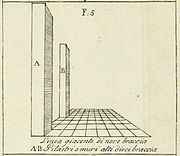
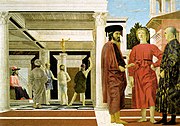


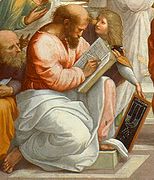
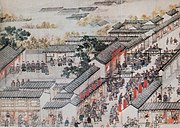
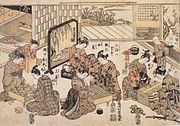


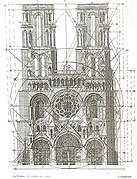

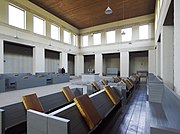










![Tupa Inca tunic from Peru, 1450 –1540, an Andean textile denoting high rank[70]](http://upload.wikimedia.org/wikipedia/commons/thumb/a/a2/Tupa-inca-tunic.png/152px-Tupa-inca-tunic.png)

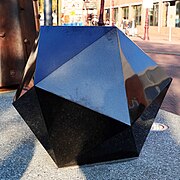

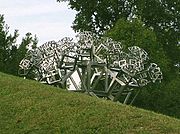
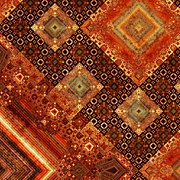


![Four-dimensional space to Cubism: Esprit Jouffret's 1903 Traité élémentaire de géométrie à quatre dimensions.[163][e]](http://upload.wikimedia.org/wikipedia/commons/thumb/3/3b/Jouffret.gif/129px-Jouffret.gif)






![Mathematical origami: Spring Into Action, by Jeff Beynon, made from a single paper rectangle.[190]](http://upload.wikimedia.org/wikipedia/commons/thumb/9/9d/Origami_spring.jpg/180px-Origami_spring.jpg)

